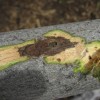Abstract
Thousand cankers disease of walnut is a tree disease of the edible nut-producing and ornamental tree, black walnut. The first diseased trees were observed in New Mexico in the 1990s. The disease has since spread to most of the western states. Until 2009, diseased black walnut trees were only found outside of the natural range of black walnut, which occurs from the mid-Atlantic states to just west of the Mississippi River. In 2009, it was found near Knoxville, Tennessee; it has since spread to Pennsylvania and Virginia. It is possible that within the next decade this disease could naturally spread to Florida. However, if people continue to move TCD infested walnut logs from place to place, this disease could arrive in Florida tomorrow. This 3-page fact sheet was written by Don Spence and Jason A. Smith, and published by the UF Department of School of Forest Resources and Conservation, February 2013.
References
Colorado State University Department of Bioagricultural Sciences and Pest Management, Thousand Cankers Disease / Walnut Twig Beetle webpage http://www.colostate.edu/Dept/bspm/extension%20and%20outreach/thousand%20cankers.html
Kolarik, M., E. Feeland, C. Utley and N. Tisserat. 2011. Geosmithia morbida sp. nov., a new phytopathogenic species living in symbiosis with the walnut twig beetle (Pityophthorus juglandis) on Juglans in USA. Mycologia, 103(2): 325-332. https://doi.org/10.3852/10-124
Tisserat, N., Cranshaw, W., Leatherman, D., Utley, C., and Alexander, K. 2009. Black walnut mortality in Colorado caused by the walnut twig beetle and thousand cankers disease. Online. Plant Health Progress doi:10.1094/PHP-2009-0811-01-RS. https://doi.org/10.1094/PHP-2009-0811-01-RS
USDA Forest Service, Northeastern Area http://www.na.fs.fed.us/pubs/silvics_manual/volume_2/juglans/nigra.htm
Unless otherwise specified, articles published in the EDIS journal after January 1, 2024 are licensed under a Creative Commons Attribution-NonCommercial-NoDerivs 4.0 International (CC BY-NC-ND 4.0) license.

